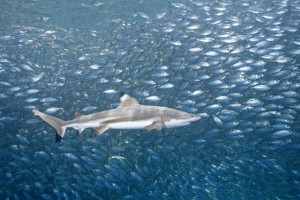In recent weeks, the country has heard about shark attacks off the Carolina coast and great whites off the northern coast of the Gulf of Mexico – then of course, we just completed “Shark Week”. This sometimes makes visitors to our beaches a bit unnerved about swimming. Each year we hear about how other activities we engage in are much more dangerous than swimming in the Gulf where there are sharks – and this is true – but we may still have a concern in the back of our minds. So – we will give you some information that will hopefully enlighten you on the issue of sharks.
First, what kind of sharks are in the Gulf and how common are they?
According to Dr. Hoese and Dr. Moore from Texas A&M, there are 30 species of sharks who have been found in the Gulf of Mexico – and this includes the great white. They range in size from the Cuban Dogfish (3 ft.) to the whale shark (60 ft. in length). Each has their own niche. Some, like the large whale sharks, are plankton feeders. Others, like the blue and mako, are open ocean travelers covering large stretches of water hunting prey. Others, like the blacktip and spinner, are more common near shore – close to estuary outfalls where food is plentiful. And others still, like nurses sharks, are bottom dwellers feeding on slow fish and crustaceans.

The Bull Shark is considered one of the more dangerous sharks in the Gulf. This fish can enter freshwater but rarely swims far upstream. Photo: Florida Sea Grant
As far as how common they are – I was involved in shark tagging in the early 1980’s and we tagged several species. Blacktips and spinner sharks were very common. We also tagged a lot of bull and dusky sharks – though dusky sharks are declining. Tiger sharks were not as common at the time. It was believed this was due to an increase in shark rodeos in the 1970’s – which were popular during the “Jaws” films. However, those events stopped for several years and recent shark events have once again captured tigers. There are five species of hammerheads that were tagged – the scalloped and bonnethead were the most common. White sharks and makos are in the Gulf but were never tagged. It was believed they spent more time offshore (where we were not sampling). Both species have been seen closer to shore in recent years, but there are no reports of any problems from this. It is possible they have been doing this all along and were just undetected. Blacknose, finetooth, and silky sharks were also frequently tagged.
People are probably not surprised to hear that sharks frequent the bays. Many of the species mentioned above do so. The small (3 ft.) Atlantic sharpnose shark is one of the most common. Sawfish were once common in the estuaries but have declined significantly across the region to do over harvesting in the early 20th century. They are currently protected.
You have probably also read that bull sharks have been found in freshwater rivers – and this is the case. Some have been found several miles up river systems.
What type of prey do sharks prefer and how to do they select and hunt for them?
This, of course, varies from species to species. Plankton feeding whale sharks generally cruise slowly through the water column filtering small fish and crustaceans – the same as the great whales. They do tend to feeding in deeper water during the day and closer to the surface at night. They are following what is known as the Deep Scattering Layer. This is a large layer of zooplankton (animal plankton) that migrates each day – deeper (600 feet or so) during the daylight hours and closer to the surface in the evenings.
Bottom dwelling sharks feed on benthic creatures like flounder and crabs. Many have the ability to detect their prey buried beneath the sand using electric perception they have.
Many species of sharks are what we call “ram-jetters”. This means they do not have a pump system to pump water over their gills. So, in order to breath, they must swim forward. Swimming continuously requires a lot of energy. Most of them are what we call opportunistic feeders – meaning they will grab what they can. Stomach analysis of such sharks find primarily fish and squid, but other creatures have been found – such as birds and even other sharks. The general rule here is seek prey that is “easy”. If your objective in feeding were to obtain energy – it would not make since to chase prey that would require a lot of energy to catch. Simple first, and take opportunities when you can. It is the ram-jetter species that people are most concerned. Swimming and taking opportunities. However, evidence suggest that we are not a prey of choice, not good opportunities. More on this in a minute.
Tiger sharks are interesting. It is in their stomachs we find such things as hubcaps, metal, and other sorts of garbage. Because of their tooth design, they are also capable of eating sea turtles.
How often do shark attacks on humans actually occur and what were the people doing that may have enticed it to happen?
Records on human shark attacks are kept at the International Shark Attack File at the Florida Museum of Natural History in Gainesville, FL. This data set only logs unprovoked attacks – those where the people were doing their thing and all of a sudden… Not those where humans were pulling them into their boats after fishing or grabbing their tails while diving.

Blacktip sharks are one of the smaller sharks in our area reaching a length of 59 inches. They are known to leap from the water. Photo: Florida Sea Grant
Based on this data – there have been 3031 unprovoked shark attacks reported worldwide since 1580 A.D. This equates to seven attacks / year. Granted… not all attacks are reported, particularly from the undeveloped regions of the world – and from early history, but it does give us something to look at.
Currently, we are averaging between 70 and 100 shark attacks worldwide and between 5-15 of these are fatal. Honestly, this is very low when compared to other activities in which humans participate.
| Year | Deaths from Other | Deaths from Shark Attacks |
| 1959 – 2010 | Lightning strikes – 1970 | 26 |
| 2004 – 2013 | Rip Currents – 361 | 8 |
| 2001 – 2013 | Dog bites – 364 | 11 |
| 2000 – 2007 | Hunting accidents – 441 | 7 |
| 2002 – 2013 (Florida only) | Boating accidents – 782 | 2 |
As you can see… the risk is much lower.
It is true that most of the shark attacks worldwide are in the United States (46%) and that most in the U.S. are in Florida (56%). However, it is believed that this is due to the number of Americans (and Floridians) who enjoy water activities. In Florida, most of the encounters have been on the east coast – 89% of them! There have only been 65 attacks reported from the west coast – only 37 from the Florida panhandle – since 1580 A.D. There have only been six reported from Escambia County and one from Santa Rosa in that time.
As far as what people were doing when a shark attack occurred – most were surfing, but swimming has increased in recent years. This is believed to be connected to the increase in the number of humans swimming. The human population visiting beaches, particularly in the U.S., has increased significantly. Most shark attacks occur in near shore waters – which would make sense… that is where we are. Most are the “hit & run” version – meaning the shark hits the person and runs… not returning. Based on Florida reports, it is believed most of these are blacktips, spinners, and blacknose sharks. These rarely end in a fatality. “Bump & Bite” – meaning the shark circles, bumps the person, and then bites, are not as common. It is believed most of these are from great whites, tigers, and bull sharks. The few fatalities that happen are usually from this form of encounter.
Summary
When assessing “risk” in an activity you have to consider “control”. This means that the more you are in control of the situation, the less risky the activity seems to be. Most feel that in the water, the shark is in control – this increases our fear and risk concern. However, as mentioned in this article, many of the other activities we are involved – where we think we are in control – are far more risker than swimming on the open Gulf of Mexico.
However, shark attacks do occur and there are a few things swimmers can do to reduce their risk.
- Do not swim alone – all predators will try and isolate an individual from a group before they attack – much easier to attack an individual than a group
- Do not swim near dusk or after dark – to increase their chance of hunting success, sharks are more actively hunting in low light conditions
- Remove shiny objectives like jewelry – sunlight hitting metal objectives can appear to be baitfish to a shark
- Avoid blood in the water – it is true they have an excellent sense of smell – small amounts of blood in the water can be detected as far away as 100 feet suggesting easy prey nearby. Avoid swimming near fishing activity where bait and fish blood may be discharged into the water
I have been swimming in the Gulf all of my life. It is too much fun to worry about a low risk encounter with a shark. Follow the simple rules suggested by the ISAF and you should not have any problems.
Resources
The International Shark Attack File – https://www.floridamuseum.ufl.edu/shark-attacks/.
Hoese, H.D., R.H. Moore. 1977. Fishes of the Gulf of Mexico; Texas, Louisiana & Adjacent Waters. Texas A&M Press, College Station TX. pp. 327.
- St. Joe Red Tide Claiming Terrapins - December 15, 2025
- The 2025 Snake Watch Report for the Pensacola Bay Area - December 15, 2025
- Rattlesnakes on Our Barrier Islands; Part 2 – Prey Selection - December 15, 2025
